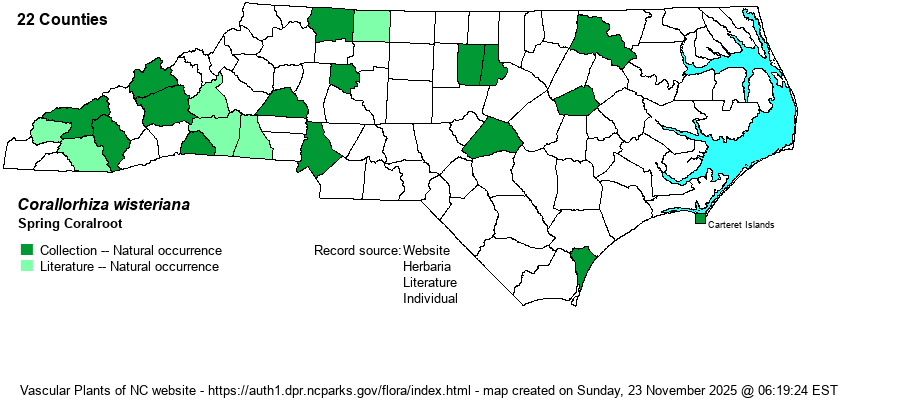| Author | Conrad | |
| Distribution | Widely scattered over the Mountains and Piedmont; there are records for only 25-30% of the counties in these regions and most of these are now of historical occurrence. Also disjunct records near the coast from Carteret (last seen in 1997 on Shackleford Banks) and New Hanover counties. Essentially absent over nearly all of the Coastal Plain. As it occurs well to the north and south of NC, it could theoretically be found nearly anywhere in the state.
This has a wide east-west range, from the Atlantic to the Rocky Mountains. It occurs north to PA and IL, and south to southern FL and TX. | |
| Abundance | Formerly rare to very uncommon in the Mountains and western Piedmont, and very rare to rare in the eastern Piedmont. However, all Corallorhiza species in NC have undergone massive declines recently, perhaps much due to deer browse, and this species is now very rare in NC, though not quite as in danger of extirpation as is C. maculata. The NC NHP does list the species as Significantly Rare, with an S1 state rank; however, it needs to be added to the State Protected list soon, as Endangered or Threatened. | |
| Habitat | Unlike the other two coralroots, this species is essentially limited to high pH forested soils, more so than most all other orchids (which are often found in acidic soils). It is mainly found in Rich Cove Forests and Basic Mesic Forests, but it can rarely be found in drier forested habitats but still over limestone, shell middens, and mafic rocks. | |
| Phenology | The only spring-blooming Corallorhiza, flowering from February to May, though mainly late March and April; fruits from March to June, and thus is underground by early summer. | |
| Identification | This is a saprophytic species, and thus it has no green coloration or leaves. The purple-brown stem grows to an average of 1 foot tall, and the top third or quarter consists of the inflorescence. It has an average of about 8 flowers, widely spaced; each (including the narrow pedicel) flower is 1/2-2/3 inch long, tubular in shape, being purplish-brown -- the same color as the stem -- with a white lip that is purple-spotted. As with the other two coralroots, it is quite scarce and can be easily overlooked, especially as it does not usually occur in large stands, at least in NC. | |
| Taxonomic Comments | None
| |
| Other Common Name(s) | Wister's Coralroot | |
| State Rank | S1 | |
| Global Rank | G5 | |
| State Status | SR-O | |
| US Status | | |
| USACE-agcp | UPL link |
| USACE-emp | FAC link |

